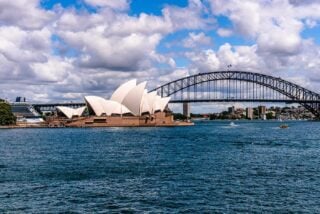
Australia is home to one of the highest overall cancer survival rates in the world. But 25,000 Australians die from rare cancers like mesothelioma each year, which is over half of all the cancer deaths in the country. Though mesothelioma only accounts for about 600 new diagnoses and around 600 deaths each year in Australia, it’s still a growing problem. The number of cases has generally increased each year since 1982, with a peak so far in 2011 with 690 diagnoses. However, various researchers in Australia have estimated another increase in cases through 2021.
Asbestos was fully banned in 2003, but government agencies estimate that at least one-third of all the homes throughout the country contain asbestos materials, and the toxin can also still be found in many workplaces. Mesothelioma is preventable, but even with a full ban there is still a lot of work ahead to eliminate the disease.
Over the years, Australia has experienced thousands of losses to mesothelioma, including many famous individuals. Their careers and lives cut short highlight the need for further action against this dangerous toxin.
Peter Leonard (February 21, 1942 – September 23, 2008)
Peter Leonard was a journalist and newsreader for decades, beginning his career on the radio with Canberra station 2CA as a copywriter. Eventually, Leonard worked his way up to announcer. After 10 years with 2CA, Leonard moved to ABC Canberra as a radio announcer, and eventually a television newsreader and weather person for another 20 years. But many regard his most notable role as a television personality for WIN News in Canberra, which he held from 1991 until 2007.
For Leonard, it was extremely difficult to retire after so long both on and off screen. His accomplishments led him to being the first person to win the Chief Minister-Public Relations Institute of Australia (ACT Division) Award for Community Media in 2007. He loved his job, but loved his community more so. In 1991, he was honored with Canberra Citizen of the Year for all of his charity work, and was even made an honorary ambassador.
But at the start of the new year in 2008, Leonard was diagnosed with mesothelioma. Though it’s not quite clear how he was exposed to asbestos, some reports stated it occurred during home renovations in the past. Since asbestos was heavily used in construction around the world, renovations remain a large concern for potential exposure. Sadly, Leonard’s retirement was spent battling this rare disease and he passed away nine months later.
Bob Bellear (June 17, 1944 – March 15, 2005)
Bob Bellear was a noted social activist, lawyer, and judge in Australia, and was even the first Aboriginal to become a District Court judge. Before beginning his long career in law, however, Bellear was first a school dropout with little employment prospects. After struggling to find a job, he joined the Royal Australian Navy, where he held an apprenticeship as an engineer and was also trained in diving. His career in the Navy led him to being the first indigenous person to receive the rank of Petty Officer.
After leaving the Navy in 1968, Bellear worked with a number of agencies to better advocate for Aboriginals. In 1972, he decided to pursue his law degree and after receiving a high school certificate, attended the University of New South Wales. He became only the second indigenous person to graduate from the college at that time. His law career led him to many different positions, most notably as District Court Judge of New South Wales from 1996 until 2005.
His career was cut short upon being diagnosed with peritoneal mesothelioma. Unfortunately, in addition to all his learned skills during his naval career, Bellear also was exposed to asbestos. All veterans, but especially those in the Navy, are at a high risk of exposure because the toxin was so heavily used. Navy vessels contained high levels of asbestos throughout, in everything from the boiler room to living quarters. As an engineer, he worked extensively in the boiler room and removed asbestos lagging often from pipes.
Bellear continued to work as long as he could leading up to his final days. Upon his death, the government granted a state funeral that was attended by 2,000 people honoring his long career.
Lincoln Hall (December 19, 1955 – March 20, 2012)
Lincoln Hall was a famed mountain climber and known as a fearless adventurer. His largest feat was climbing Mt. Everest in May 2006, though the climb nearly defeated him. After reaching the summit, Hall lost consciousness on the teams’ descent back down the world’s highest mountain. He was even left for dead and pronounced dead, but somehow survived for 12 hours in the subzero temperatures without food or oxygen before a British climbing team found him. Hall found a way to live and was able to continue his love of climbing.
He was able to cheat death that night, but five years later a different unseen killer would come for him. Hall was diagnosed with mesothelioma in 2011. The source of his exposure could be traced back to when he was just nine years old. He and his father spent time building two cubby houses at their home in Canberra using asbestos-cement sheets.
Despite his love of climbing high summits, Hall’s friends and fellow climbers knew him as one to not take unnecessary risks and look after his health. The diagnosis was an unexpected and devastating end to his eventful career. Hall and his family understood their legal rights, and were able to file a successful claim for compensation during his brief battle.
[[financial-assistance]]
Sir David Martin (April 15, 1933 – August 10, 1990)
Sir David Martin was a senior officer for the Royal Australian Navy and later became the governor of New South Wales. Martin came from a long line of naval officers, and decided to uphold the tradition. He served a long career from joining the Navy in 1946 as a cadet midshipman until his retirement in 1988. Sadly his long naval career meant long-term exposure to asbestos.
Through his service, Martin continued to move up in the ranks and saw many accomplishments. In 1974, he was promoted to Commander of the Third Australian Destroyer Squadron. He commanded several ships, and was promoted again to Chief of Naval Personnel and then Commander of Naval Support Command. In 1985, Martin was even appointed by the Queen as Officer of the Order of Australia for his service. In 1988, he was honored again with a knighthood.
Following his naval career, Martin was elected and sworn in as governor on January 20, 1989, but his new career would end abruptly. Though he tried for a time to hide his pleural mesothelioma cancer diagnosis and continue working, by August 1990 he was forced to resign. Martin sadly died just three days after officially retiring, but will always be remembered for his great service to Australia throughout his life.
Harold Hopkins (March 6, 1944 – December 11, 2011)
Harold Hopkins was a well-known actor, who had starred in numerous films and television series, like Don’s Party and Gallipoli. Before he began his acting career, Hopkins was an apprentice carpenter. He worked directly with asbestos materials, like asbestos sheeting, while he worked in south Queensland in the 1960s.
Hopkins was diagnosed with mesothelioma just a few months before his death in December. But despite the grim prognosis, Hopkins family said he went on an audition just days after receiving his diagnosis. He auditioned for the role of Henry C. Gatz, Gatsby’s estranged father, in Baz Luhrman’s The Great Gatsby. Even though Hopkins realized his prognosis would hold him back from being able to actually play the character on screen, he didn’t want to back away from such an incredible opportunity to showcase his skill and passion.
Bernie Banton (October 13, 1946 – November 27, 2007)
Bernie Banton was a social justice campaigner, best known for his efforts to help those suffering from asbestos-related diseases. Banton was exposed to asbestos himself after working with his brother, Ted, at the James Hardies facility in Sydney. The company specialized in fiber cement products, as well as other asbestos products. Banton was part of the production line, and the asbestos dust that would cover the workers led to the nickname “The Snowmen.” An Australian report said of the 137 workers in the factory in 1974, only ten were still alive by 2006. Banton lost his brother to mesothelioma in 2001.
As a result of his exposure, Banton suffered several asbestos-related diseases. He was first diagnosed with asbestosis, and later learned he had peritoneal mesothelioma. His conditions caused Banton to be on oxygen all the time. Despite his poor health, he continued to lobby for asbestos victims and eventually helped set up the Jackson Commission, which worked to ensure the Hardies corporation fairly compensated asbestos victims for their negligence. Efforts like this led to Banton’s honor of being made a Member of the Order of Australia for his service to the community. The government held a state funeral and lowered the Australian flags to half-mast out of respect.
Hopefully, with the continued efforts of advocates like the late Banton around the world, asbestos will one day be a thing of the past. Even with a ban in a growing list of countries like Australia, there is still a long way to go to eliminate its dangers for good.




